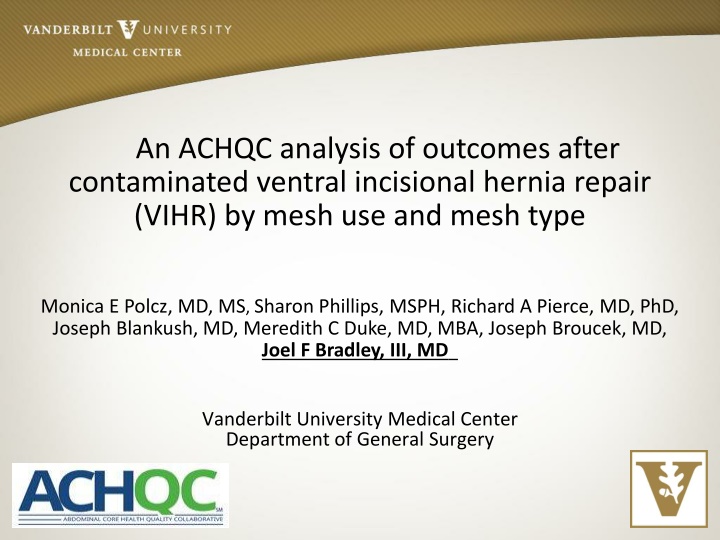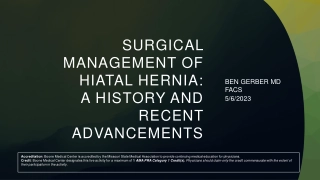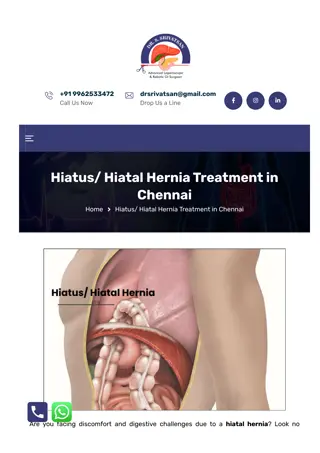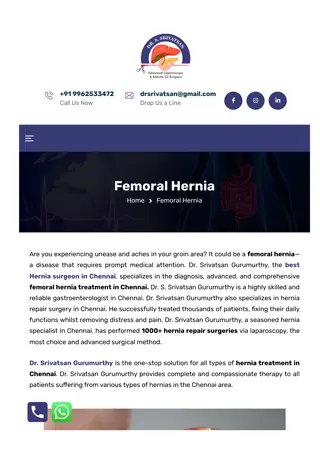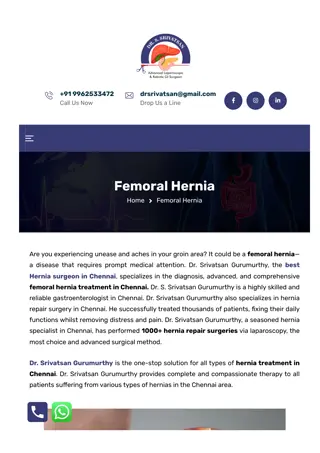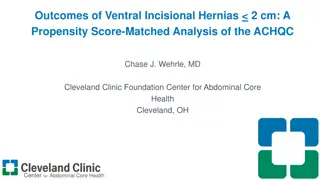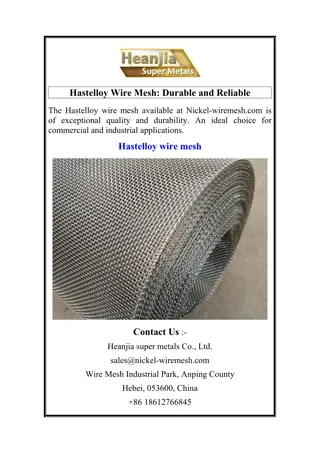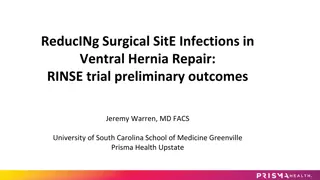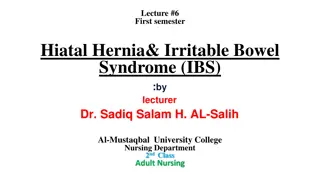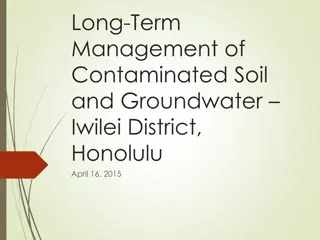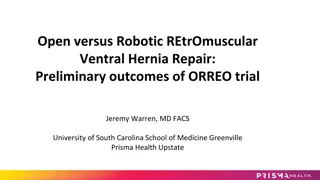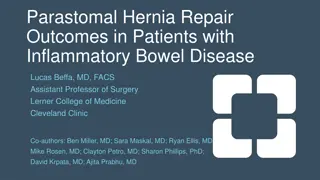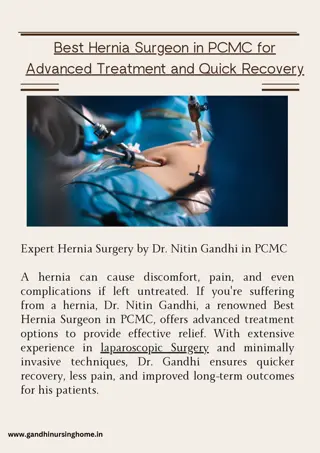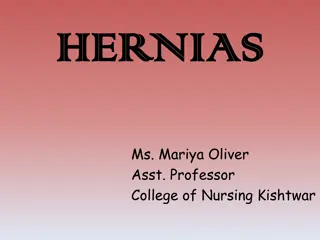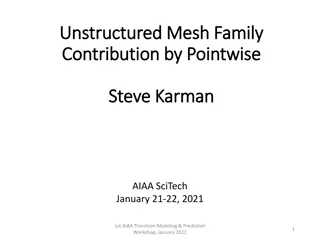Analysis of Mesh Types in Contaminated Ventral Hernia Repair
This study analyzes outcomes after contaminated ventral incisional hernia repair (VIHR) by comparing various mesh types including biologic mesh, permanent synthetic mesh, resorbable synthetic mesh, and primary repair. The research aims to characterize surgical site infection, recurrence rates, and other key factors in 1905 patients. Results indicate differences in outcomes based on mesh type, with implications for surgical decision-making.
Download Presentation

Please find below an Image/Link to download the presentation.
The content on the website is provided AS IS for your information and personal use only. It may not be sold, licensed, or shared on other websites without obtaining consent from the author.If you encounter any issues during the download, it is possible that the publisher has removed the file from their server.
You are allowed to download the files provided on this website for personal or commercial use, subject to the condition that they are used lawfully. All files are the property of their respective owners.
The content on the website is provided AS IS for your information and personal use only. It may not be sold, licensed, or shared on other websites without obtaining consent from the author.
E N D
Presentation Transcript
An ACHQC analysis of outcomes after contaminated ventral incisional hernia repair (VIHR) by mesh use and mesh type Monica E Polcz, MD, MS, Sharon Phillips, MSPH, Richard A Pierce, MD, PhD, Joseph Blankush, MD, Meredith C Duke, MD, MBA, Joseph Broucek, MD, Joel F Bradley, III, MD Vanderbilt University Medical Center Department of General Surgery
Disclosures None
Introduction The optimal mesh for use in contaminated ventral incisional hernia repair remains unclear
Objective To characterize outcomes after contaminated ventral incisional hernia repair (VIHR) using Primary repair / no mesh (PR) Biologic mesh (BM) Permanent synthetic mesh (PSM) Resorbable synthetic mesh (RSM)
Methods ACHQC hernia registry Adults undergoing Open VIHR CDC Class II or III wounds Excluded parastomal Excluded concomitant inguinal
Methods 1905 Patients in the analysis 30-day surgical site infection (SSI) surgical site occurrence (SSO) surgical site occurrence requiring procedural intervention (SSO-PI) 1 year recurrence
Results PSM (1110, 58.3%) RSM (234, 12.3%) BM (298, 15.6%) Primary (263, 13.8%) N = 1912 P-value 60 60 59 60 Age 0.95 (51-68) (51-59) (61-68) (50-68) Female 55% 58% 59% 60% 0.34 32 32 33 33 BMI 0.67 (28-37) (28-38) (28-38) (27-38) DM 24% 24% 25% 26% 0.94
Results PSM (1110, 58.3%) RSM (234, 12.3%) BM (298, 15.6%) Primary (263, 13.8%) N = 1912 P-value Current Smoker 10.4% 11.1% 10.8% 13.4% 0.012 CDC Class 3 24% 33% 41% 35% <0.001 Nonelective 4.1% 6.0% 10.4% 19.0% <0.001 Academic 85.6% 85.5% 74.8% 77.2% <0.001
Results RSM PSM BM Primary P-value 30 day SSI 11% 15% 13% 13% 0.2 6.6% (8/113) 2.9% (1/34) 2.5% (1/39) Mesh excision - 0.68 30 day SSO 18% 18% 22% 10% 0.002 30 day SSO-PI 13% 17% 20% 15% 0.045 1 year recurrence* 24% (60/255) 22% (8/37) 32% (14/44) 17% (4/23) 0.54 *N=360 (19%)
Odds SSI Compared to Permanent Synthetic Resorbable: 1.49 (95%CI 0.98-2.28) Biologic: 1.13 (0.75-1.70) Primary repair: 1.47 (0.85-2.54) CDC Class 3 - 1.64 (1.22-2.21) History abd wall SSI - 1.44 (1.07-1.94)
Odds SSO Compared to Permanent Synthetic Resorbable: 1.03 (95%CI 0.70-1.51) Biologic: 1.29 (0.91-1.81) Primary: 0.42 (0.24-0.73) CDC Class 3 0.93 (0.70-1.23) BMI 1.15 (1.03-1.28) History abd wall SSI 1.37 (1.04 - 1.79)
Odds SSO-PI Compared to Permanent Synthetic Resorbable: 1.34 (95%CI 0.89-1.99) Biologic: 1.46 (1.02-2.09) Primary: 1.49 (0.92-2.19) Contaminated 1.37 (1.03-1.82) BMI 1.15 (1.03-1.29)
Odds 1-year recurrence Compared to Permanent Synthetic Resorbable: 0.66 (0.31-1.40) Biologic: 0.86 (0.47-1.59) Primary: 0.39 (0.14-1.10) Contaminated 1.01 (0.62-1.63) Hernia width 1.29 (1.13-1.49)
Conclusions Compared to Permanent Synthetic No difference in SSI Decreased odds of SSO with Primary Increased odds of SSO-PI with Biologic No difference in 1-year recurrence (low follow up)
Conclusions High rate of wound complications and recurrence in contaminated wounds Consideration for separating CDC Class 2 and 3 for future studies
An ACHQC analysis of outcomes after contaminated ventral incisional hernia repair (VIHR) by mesh use and mesh type Monica E Polcz, MD, MS, Sharon Phillips, MSPH, Richard A Pierce, MD, PhD, Joseph Blankush, MD, Meredith C Duke, MD, MBA, Joseph Broucek, MD, Joel F Bradley, III, MD Vanderbilt University Medical Center Department of General Surgery
